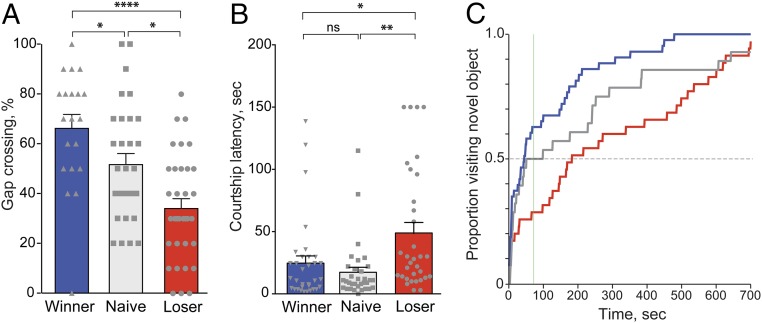Fig. 3.
Generalization of the loser and winner effect. Testing loser and winner flies in three different behavioral paradigms showed that the effect of persistently losing or wining fights extended to other behaviors. All behaviors were assayed 24 h after training. (A) Gap crossing. Winners and losers showed increased and decreased success, respectively, in crossing a 3-mm gap compared with naive CS males. Steel–Dwass multiple comparison test after nonparametric ANOVA, *P < 0.05, ****P < 0.0001; nloser = 34, nwinner = 20, nnaive = 31. (B) Courtship. Losers exhibited significantly prolonged courtship latency compared with naive and winner flies, when paired with wild-type virgin females. Tukey’s multiple comparisons test after one-way ANOVA: *P < 0.05; **P < 0.01, n = 33 for all groups. (C) Object exploration. A greater number of flies with repeat winning experience (blue; n = 35) had moved toward and climbed the post by 76 s into the observations (green vertical line; t50, based on concurrently run naive SH CS males, gray; n = 28), than those that had chronically lost (red; n = 43), χ2, P = 0.0026. Prior fighting experience appeared to affect the exploration of males in comparison with naive males; however, the trends failed to be statistically significant: At t50 (the time at which 50% of flies had reached the post), 63% of flies with repeat winning experience had found the post (winners vs. naive; χ2, P = 0.2863) and yet only 29% of the chronic losers (losers vs. naive; χ2, P = 0.0818). ns, nonsignificant.

